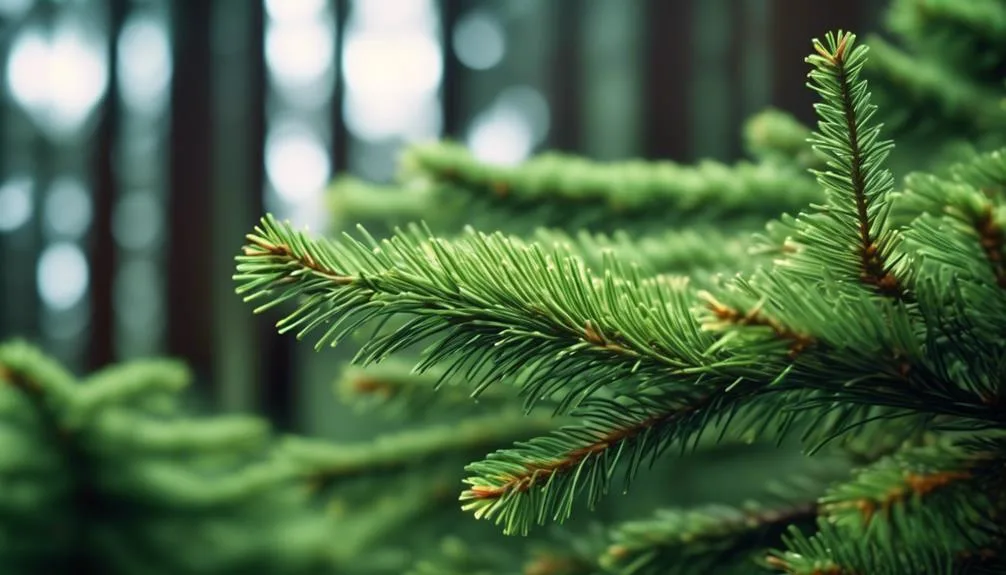You're taking a quiet moment in your garden, admiring your beautiful spruce trees, when you notice some changes in their appearance. Don't worry—dealing with common spruce tree diseases can be manageable with the right knowledge.
In this discussion, we'll explore practical strategies for identifying and managing these diseases to keep your spruce trees healthy and thriving.
Identifying Common Spruce Tree Diseases
When identifying common spruce tree diseases, it's important to be observant of any changes in the tree's appearance and take prompt action to address any issues. Regular tree inspection is key to catching diseases early. Look for signs such as discoloration, unusual spots, or abnormal growth patterns. If you notice any of these symptoms, it's crucial to conduct a thorough disease diagnosis.
Check for common spruce tree diseases like needle cast, root rot, or canker diseases. Pay attention to any changes in the tree's overall health and vigor. By staying vigilant and conducting proper disease diagnosis, you can effectively identify and address common spruce tree diseases before they cause significant harm to the tree.
Regular tree inspection and prompt action are essential for maintaining the health of your spruce trees.
Understanding Disease Symptoms
To understand disease symptoms in your spruce trees, observe for any changes in the tree's appearance and take prompt action to address any issues.
Recognizing early signs of disease is crucial for effective treatment. Look for discoloration, wilting, or abnormal growth in the needles and branches. Browning or yellowing of needles, stunted growth, and premature needle drop are common symptoms of various spruce tree diseases.
Additionally, inspect the trunk for any signs of cankers, oozing sap, or unusual swelling. Keep an eye out for pest infestations, as they can also lead to disease symptoms in spruce trees.
Proper diagnosis of symptoms is essential for treating effectively. Once symptoms are identified, consult with a professional arborist to develop a targeted treatment plan to restore the health of your spruce trees.
Implementing Disease Management Strategies
You can effectively manage spruce tree diseases by implementing proper sanitation and cultural practices in your landscape maintenance routine.
Start by choosing disease-resistant varieties when planting new spruce trees. These varieties are less susceptible to common diseases, reducing the need for intensive management.
Additionally, cultural practices such as adequate watering, proper pruning, and maintaining good air circulation around the trees can help prevent disease development.
Regularly removing and disposing of any fallen or diseased plant material is crucial to prevent the spread of diseases.
It's also important to monitor the health of your spruce trees closely and address any issues promptly.
Preventive Measures for Healthy Spruce Trees
Incorporating preventive measures into your landscape maintenance routine will contribute to the overall health and resilience of your spruce trees, reducing the risk of diseases and minimizing the need for intensive management. To keep your spruce trees healthy, consider the following:
- Pruning Techniques: Regularly prune dead or diseased branches to promote air circulation and sunlight penetration, which can help prevent fungal infections and pest infestations.
- Fertilization Methods: Use a balanced fertilizer specifically formulated for evergreen trees in the early spring to provide essential nutrients for healthy growth and improved resistance to diseases.
- Mulching: Apply a layer of organic mulch around the base of the tree to retain moisture, regulate soil temperature, and reduce weed competition, thus enhancing the tree's overall health.
Seeking Professional Assistance
Consider consulting with a certified arborist to assess the health of your spruce trees and provide professional guidance on disease management and preventive strategies.
Disease diagnosis is a complex task that requires specialized knowledge and tools. An expert consultation with a certified arborist can help accurately identify any diseases affecting your spruce trees. These professionals have the expertise to recognize the symptoms and patterns associated with various tree diseases, enabling them to recommend the most effective treatment plan.
Additionally, they can offer valuable preventive strategies to protect your spruce trees from future diseases. By seeking professional assistance, you can ensure a thorough and accurate assessment of your trees' health, as well as access to the best possible care and management techniques.
Conclusion
Incorporating these techniques into your tree care routine will help safeguard your spruce trees against common diseases, ensuring their long-term health and vitality.
By staying vigilant, employing effective management strategies, and seeking professional guidance when needed, you can nurture resilient and beautiful spruce trees for years to come.

My interest in trees started when I first saw the giant sequoias in Yosemite.
I was a teenager then, and I remember thinking, “I need to learn more about this.”
That moment stuck with me.
A few years later, I went on to study forestry at Michigan Tech.
Since graduating, I’ve worked in a mix of hands-on tree care and community education.
I’ve spent over ten years helping people understand how to plant, maintain, and protect the trees in their neighborhoods.
I don’t see trees as just part of the landscape.
They are living things that make a real difference in our daily lives.
